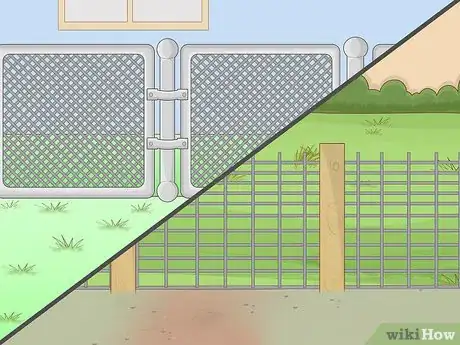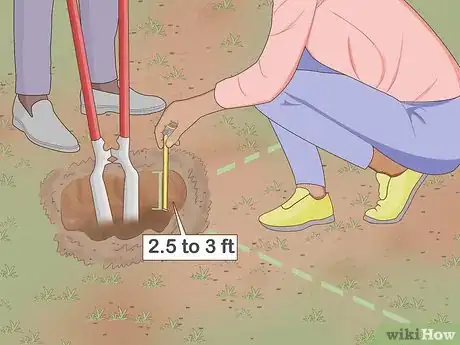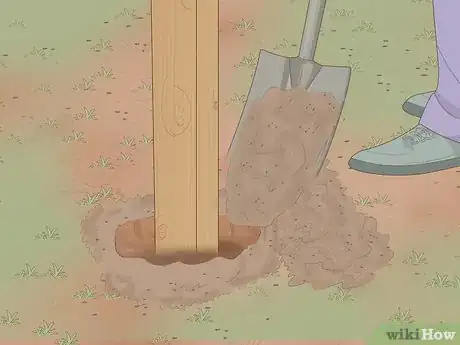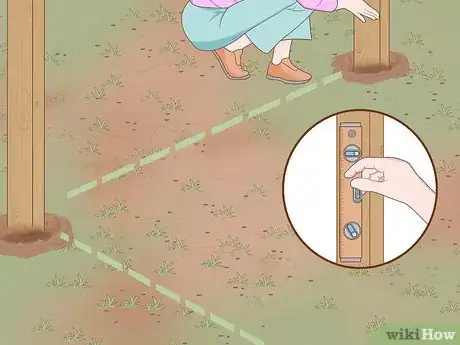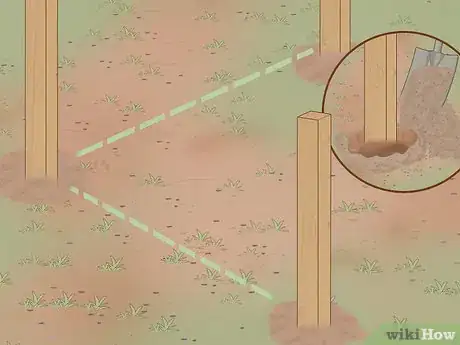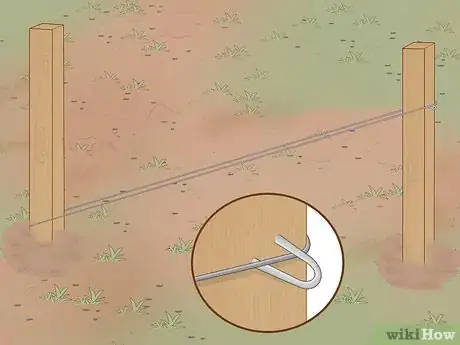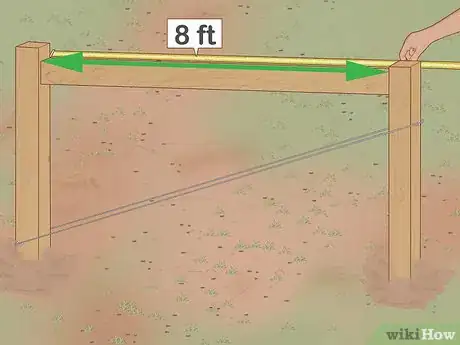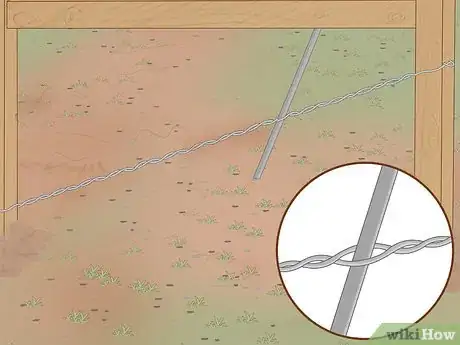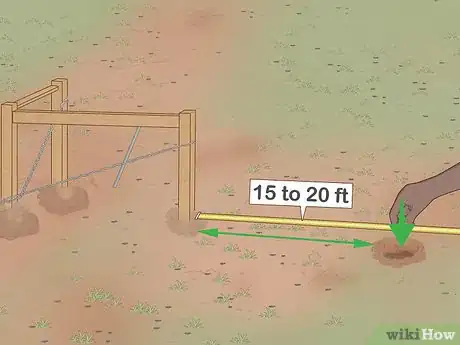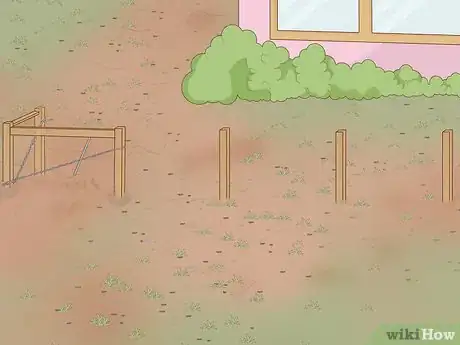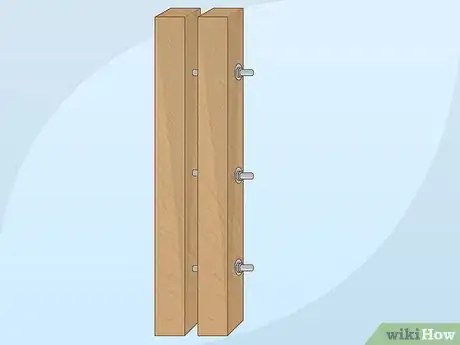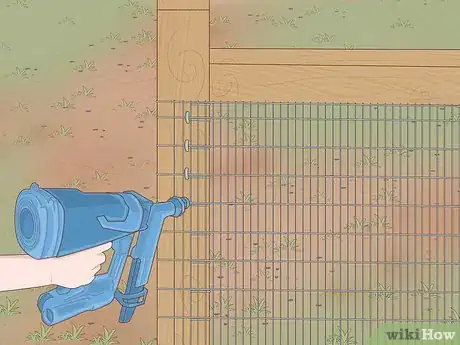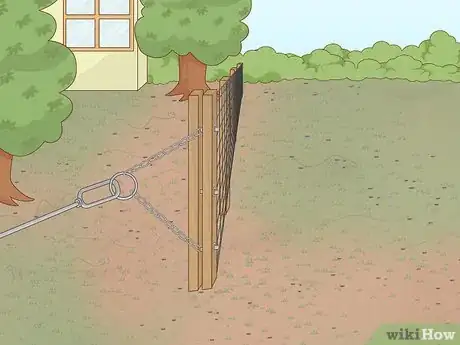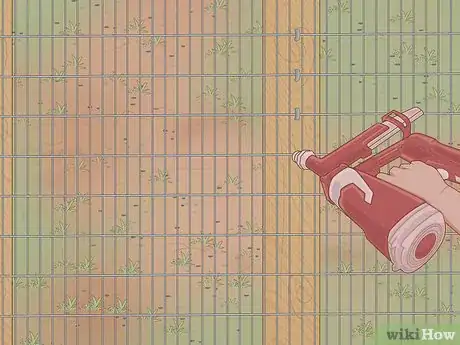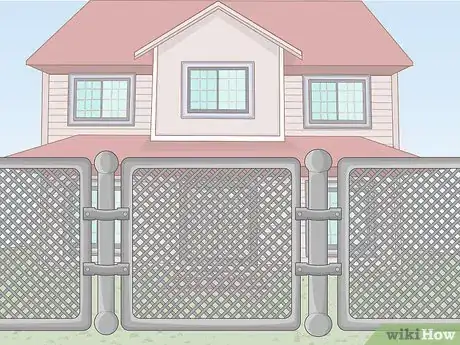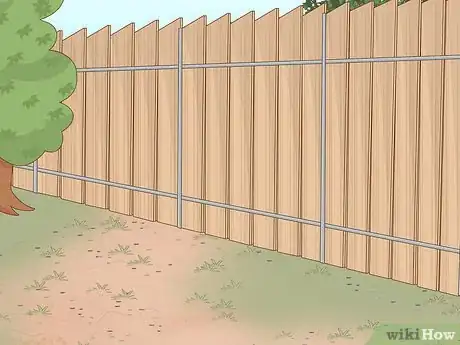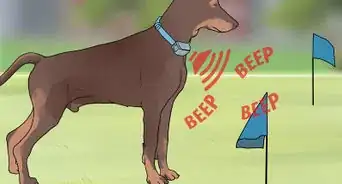This article was co-authored by Melissa Nelson, DVM, PhD. Dr. Nelson is a Veterinarian who specializes in Companion and Large Animal Medicine in Minnesota, where she has over 18 years of experience as a veterinarian in a rural clinic. She received her Doctor of Veterinary Medicine from the University of Minnesota in 1998.
This article has been viewed 103,496 times.
Making sure your dog is secure in your backyard is important to its health and your peace of mind. Putting up a fence for your dog can be a big task, but with the right materials and know-how, you can construct a fence that is sturdy and secure. Learning how to properly install your fence posts and attach woven wire to them will allow you to create a safe place for your dog to run and play.
Steps
Putting Up Fence Posts
-
1Consider what type of wire fence you would like. There are two different types of wire fences that people typically use to restrain dogs. Both will keep dogs in your yard, but they differ in durability and price.
- Chain link fence: These tend to be more expensive than other forms of wire fencing, but they are strong and durable. They will last a long time, and they are compliant with many housing associations' guidelines. That said, the large holes in the chain link can make it easy for strangers to stick in hands or objects to taunt your dog.
- Farm fence: These are cheap fences made from wire mesh stretched out over fence posts. They will not obstruct views in your yard, but they can corrode and may need frequent maintenance.[1]
-
2Dig holes for your corner posts. If you choose to use wooden posts for your fence, the first step to building a wire fence for your dog is to dig holes for your corner posts. Since corner posts have more tension on them than line posts (the posts in between your corner posts), the holes dug for them need to be deeper. The holes for your corner posts should be about 2 ½ to 3 feet (.76 to .91 meters) deep.
- You can use a hand-held clamshell post digger for most jobs. However, if you have a lot of posts or the ground is rocky and tough to dig, an auger, or drill-like tool, might be helpful.[2]
- If the ground where you are placing your posts is wet or made of clay, you will need deeper holes for your posts.
Advertisement -
3Place your corner posts in the holes. Corner posts need to be sturdier than your line posts. Generally, your corner posts should be about 6 to 8 inches (15 to 20 centimeters) in diameter and about 7 to 8 feet (2 to 2.5 meters) long. Place these posts in your corner holes and fill in the hole with just enough soil to keep them from moving around.
- Hold a level vertically to the side of the post to make sure it is straight.[3]
-
4Dig holes for your brace posts. You should install a brace post for every fence line leading to your corner post. The brace post helps take some tension off the corner post and keeps it from falling down or becoming loose. Dig holes for these posts that are 2 ½ to 3 feet (.76 to .91 meters) deep, like you did for your corner posts. The brace post should be approximately 8 feet away from the corner post, along the fence line.
-
5Place your brace posts in the holes. As you did with the corner posts, place your brace posts in the holes you’ve dug and fill in a bit of the soil to keep them in place. Hold a level vertically along the side of the post to make sure it is straight before filling it in.
-
6Fill in your corner and brace post holes. Once you have your corner and brace posts in place and level, fill in the holes with dirt, clay, or sand to keep the posts in place. You must pack the dirt, clay, or sand down as you go to make sure the post is solid. Add a little dirt at a time, making sure you pack it down well after each bit you add.
- You can use a long board, hoe, a pipe with a curved end, or similar items to pack down the dirt. This will help you pack the dirt tightly and keep you from scraping your knuckles against the wooden posts in the process.[4]
- For fences that need to be extra secure, you can pour concrete into the post hole and secure it in the ground this way.
-
7Install a brace wire. Once you have your corner and brace posts secured in the ground, install a brace wire between the two to stabilize the posts. This brace wire will run diagonally from the bottom of your corner post to the top of your brace post. To secure the wire, start a fence staple at both the bottom of your corner post and the top of your brace post. Start the wire through the staple on your corner post and run it up through the staple at the top of your brace post, around the top of the brace post, and back down and around your corner post. Once you have the wire in place, drive the staples in tightly. Staple any loose wire to the post as well.
- Brace wire is sold at most supply stores. It is usually 9-gague and flexible. It is not the same as fence wire.[5]
-
8Add a crosspiece between the corner and brace posts. Once your brace wire is in place, add a wooden crosspiece in between the top of your corner post and brace post. The crosspiece should be long enough to fit snuggly between the two posts (about 8 feet or 2.5 meters long). Make a notch on the inside of each post that you can slip the crosspiece into and secure it in place using nails.
- You can also use pipe, old steel fence posts, or even bed rails as your crosspiece.[6]
-
9Create a brace lever. You’ll need to apply tension to the brace wire to make your corner and brace posts even more sturdy. To do so, cut a piece of wood, pipe, rod, or a similar sturdy material to about 16 inches (41 centimeters) long. Place one end of this lever at the top corner of your brace post, in between the two brace wires you just secured. Twist the lever until the wires are as tight as possible. Once you have them taut, rest the other end of the lever against the crosspiece. It will stay here on its own as long as there is enough tension.[7]
-
10Dig holes for your line posts. Stretch a wire or cord between your corner and brace assemblies to determine where to place your line posts. Line posts should be placed about 15 to 20 feet (4.5 to 6 meters) apart. You can use spray paint to mark where to dig the holes for these posts. Using the clamshell post digger or auger, dig holes to a depth of 2 to 2 ½ feet (.61 to .76 meters).
-
11Install your line posts. Once you’ve dug the holes for your line posts, place your wooden posts in them and fill them in, adding a bit of dirt, clay, or sand at a time and packing it down well.
Attaching the Wire Fence
-
1Construct a fence stretcher. Woven wire fencing can be tough to stretch, but constructing a fence stretcher can make it much easier. To make a fence stretcher, take two 2x4s, each of which is a little longer than the height of the woven fence you’re using. Drill three holes in each 2x4 at even intervals along the board. Place bolts in these holes. You will hook your woven fence over the bolts in order to stretch it by pulling on the board.
- Use one 2x4 at each end of the section of woven fence you’re stretching.[8]
-
2Attach the end of the wire to the corner post. To attach the end of the post, remove a few of the vertical wires from your woven fence. Wrap these wires around the post and then weave them back into the fencing. Using a staple gun, secure the wires to the fence post.
- When you’re buying wire, remember that the higher the wire’s gauge, the smaller the wire’s diameter. For instance, 12-gauge wire is heavier than 14-gauge wire.[9]
- Generally, you’ll want to use galvanized staples that are at least an inch and a half long. However, if you are using a harder wood for your posts, you may need a shorter staple.
-
3Stretch the fence to the next corner post. Once you have one end of the wire attached to you first corner post, stand the woven wire on its end and unroll it along the outside of your fence line to the next corner post. Using your fence stretcher, stretch the fence slowly, applying pressure evenly to all your corner, brace, and line posts. Stretch the wire until the tension curves in the wire are about a third of the way straight.
-
4Attach the wire to the fence posts. Starting at the end closest to the corner post you’ve already attached your wire to, secure the woven wire to your brace and line posts using a staple gun. Attach the wire at the top of the fence post first and work your way down the post, making sure to keep the wire pulled taut the whole time.
- When you’re stapling your wire to your fence posts, drive the staples in slightly angled to the vertical axis of the post. This will help keep the wood from splitting.[10]
Putting Up Temporary or Lighter-Duty Fences
-
1Use metal posts instead of wood. For a quicker or temporary solution, you can use metal posts instead of wood. You will follow all the same guidelines for lining up the corner posts with the line posts, however, you need only to pound the metal post into the ground with a sledge hammer or post driver, cutting out the time and effort needed to dig holes for your posts. You can still create brace assemblies for your corner posts using the same method as you would for wood posts.[11]
- Metal posts come with wire clips on them that are used to secure the wire to the post. Use these to secure your wire instead of staples.[12]
-
2Purchase a pre-fabricated fencing kit. You can also purchase a pre-fabricated fencing kit to erect a safe, secure fence quickly. These kits come in a variety of heights and lengths so you can select the one that is right for your situation. These kits will come with specific instructions on how to install them. In general, however, you’ll pound the included stakes into the ground along your fence line and run a tension wire between the posts to keep them in place. You’ll then attach the wire fencing to the posts using cable wires or the wire clips on your fence posts.
- Most of these fencing systems are designed to use your house (or another building) as one side of the fence. However, if you prefer to build a fence that is not connected to your house, you can purchase gates as part of these kits as well.
-
3Buy pre-made fence panels. Another option is to purchase pre-made fence panels. These panels do not require you to set up fence posts. Instead, you place the panels in the formation you desire and pound them into the ground using a sledge hammer or post driver. To secure the panels together, attach them to the adjacent panel using cable ties or a strong wire.
References
- ↑ http://www.canismajor.com/dog/fences.html
- ↑ http://www.backwoodshome.com/how-to-build-a-good-fence-for-your-homestead/
- ↑ http://www.small-farm-permaculture-and-sustainable-living.com/fence_field_put_up.html
- ↑ http://www.backwoodshome.com/how-to-build-a-good-fence-for-your-homestead/
- ↑ http://www.backwoodshome.com/how-to-build-a-good-fence-for-your-homestead/
- ↑ http://www.backwoodshome.com/how-to-build-a-good-fence-for-your-homestead/
- ↑ http://www.backwoodshome.com/how-to-build-a-good-fence-for-your-homestead/
- ↑ http://www.backwoodshome.com/how-to-build-a-good-fence-for-your-homestead/
- ↑ http://www.backwoodshome.com/how-to-build-a-good-fence-for-your-homestead/
About This Article
To install wire fencing for dogs, start by driving metal posts into the ground approximately 15 feet apart with a sledgehammer. Then, secure the wire to the first post using the metal clips that are attached to the post. Next, unroll your wire along the outside of the fence, and clip it to the post at the other end of the fence. Finally, clip the wire onto each post along the fence so it’s firmly in place. For tips on how to build a fence using wooden posts, read on!
